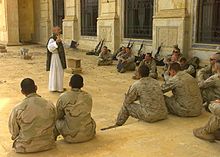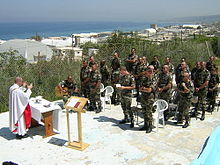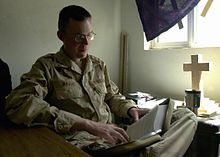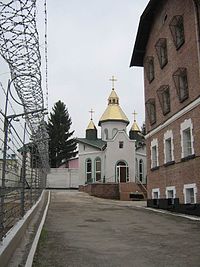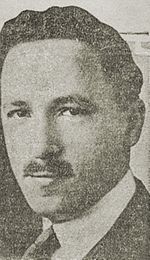- Chaplain
-
Traditionally, a chaplain is a minister in a specialized setting such as a priest, pastor, rabbi, or imam or lay representative of a religion attached to a secular institution such as a hospital, prison, military unit, police department, university, or private chapel. Though originally the word "chaplain" referred to representatives of the Christian faith,[1] it is now applied to men and women of other religions or philosophical traditions–such as in the case of the humanist chaplains serving with military forces in the Netherlands and Belgium.[2] In recent years many lay individuals have received professional training in chaplaincy and are now appointed as chaplains in schools, hospitals, universities, prisons and elsewhere to work alongside or instead of official members of the clergy.[3]
Contents
Types of chaplains
Military
A chaplain provides pastoral (spiritual) and emotional support for service personnel, including the conduct of religious services at sea or in the field. Military chaplains have a long history; the first English military-oriented chaplains, for instance, were priests on board proto-naval vessels during the 8th century. Land based chaplains appeared during the reign of King Edward I. The current form of military chaplain dates from the era of the First World War.
Chaplains are nominated, appointed, or commissioned in different ways in different countries. A military chaplain can be an army-trained soldier with additional theological training or a priest nominated to the army by religious authorities. In the United Kingdom the Ministry of Defence employs chaplains but their authority comes from their sending church. Royal Navy chaplains undertake a 16 week bespoke induction and training course including a short course at Britannia Royal Naval College and specialist fleet time at sea alongside a more experienced chaplain. Naval Chaplains called to service with the Royal Marines undertake a grueling 5 month long Commando Course, and if successful wear the commandos' Green Beret. British Army chaplains undertake seven weeks training at The Armed Forces Chaplaincy Centre Amport House and The Royal Military Academy Sandhurst. Royal Air Force chaplains must complete 12 weeks Specialist Entrant course at the RAF College Cranwell followed by a Chaplains' Induction Course at Armed Forces Chaplaincy Centre Amport House of a further 2 weeks. In the United States military, chaplains must be endorsed by their religious affiliation in order to serve in any facet of the military.[4][5]
Military Chaplains are normally accorded officer status, although Sierra Leone had a Naval Lance Corporal chaplain in 2001. In most navies, their badges and insignia do not differentiate their levels of responsibility and status. By contrast, in Air Forces and Armies, they typically carry ranks and are differentiated by crosses or other equivalent religious insignia. However, United States military chaplains Association and every branch carry both rank and Chaplain Corps insignia.
Though the Geneva Conventions do not state whether chaplains may bear arms, they specify (Protocol I, 8 June 1977, Art 43.2) that chaplains are noncombatants. In recent years both the UK and US have required chaplains, but not medical personnel, to be unarmed. Other nations, notably Norway, Denmark and Sweden, make it an issue of individual conscience. Captured chaplains are not considered Prisoners of War (Third Convention, 12 August 1949, Chapter IV Art 33) and must be returned to their home nation unless retained to minister to prisoners of war.
Inevitably, a significant number of serving chaplains have died in action. The U.S. Army and Marines lost 100 chaplains killed in action during WWII: a casualty rate greater "than any other branch of the services except the infantry and the Army Air Corps" (Crosby, 1994, pxxiii). Many have been decorated for bravery in action (five have won Britain's highest award for gallantry, the Victoria Cross). The Chaplain's Medal for Heroism is a special U.S. military decoration given to military chaplains who have been killed in the line of duty, although it has to date only been awarded to the famous Four Chaplains, all of whom died in the USAT Dorchester sinking in 1943 after giving up their lifejackets to others.
The United States European Command has co-sponsored an annual International Military Chiefs of Chaplains Conference every year since 1991.
At times, the existence of military chaplains has been challenged in countries that have a separation of Church and State.[6][7]
Prison
The State has the twofold responsibility about crime and punishment: to discourage behavior that is harmful to human rights and the fundamental norms of civil life, and to repair, through the penal system, the disorder created by criminal activity. Judicial and penal institutions play a fundamental role in protecting citizens and safeguarding the common good. By their very nature these institutions must contribute to the rehabilitation of offenders. So, prisons are a reality of any society. But, quite often, prison causes more problems than it solves.
The manifold complexity of prison chaplaincy was explained by Dr. /Measuring_Chaplaincy.htm Measuring Prison Chaplaincy]. Dr. Vance Drum wrote and presented a paper at the American Correctional Association on the nature of the professional prison Generally speaking, prisoners are often persons excluded, aborted from society. Prisoners easily can be overwhelmed by feelings of isolation, shame and rejection that threaten to shatter their hopes and aspirations for the future. Within this contex
Rabbi Philip R. Alstat (1891–1976), who—in addition to work as a chaplain in New York hospitals and senior citizen facilities—served for three decades as the Jewish chaplain for "The Tombs", the Manhattan Detention Facility, once described his service as follows: "My goals are the same as those of the prison authorities--to make better human beings. The only difference is that their means are discipline, security, and iron bars. Mine are the spiritual ministrations that operate with the mind and the heart."[8] The Africa Commandant of the Mission for Africa Chaplain corps (Apostle Dr T.L Ambel) The mission for Africa Chaplain corps Oyo state commandant Rev J.K Afolabi,The mission for Africa chaplain corps Deputy Commandant Oyo State, Rev. T.K Okeleye The mission for Africa chaplain corps Kogi state commandant Apostle keddy Balogun International commandant, Clinton, Mississippi USA Apostle Dr E.L Taylor
Parliamentary
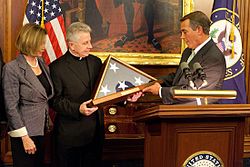 House Speaker John Boehner and Minority Leader Nancy Pelosi present a flag flown over the U.S. Capitol to Fr. Daniel Coughlin in recognition for his 11 years of service as Chaplain of the United States House of Representatives, April 2011
House Speaker John Boehner and Minority Leader Nancy Pelosi present a flag flown over the U.S. Capitol to Fr. Daniel Coughlin in recognition for his 11 years of service as Chaplain of the United States House of Representatives, April 2011
Some nations, including the United States, have chaplains appointed to work with parliamentary bodies, such as the Chaplain of the United States Senate, and the Chaplain of the United States House of Representatives. In addition to opening proceedings with prayer, these chaplains provide pastoral counseling to congressional members, their staffs, and their families; coordinate the scheduling of guest chaplains, who offer opening prayers; arrange and sometimes conduct marriages, memorial services, and funeral services for congress, staff, and their families; and conduct or coordinate religious services, study groups, prayer meetings, holiday programs, and religious education programs, as well.
Law Enforcement
Law Enforcement Chaplains serve in local, county, state and federal agencies and provide a variety of services within the law enforcement community.[9] They should not be confused with Prison Chaplains, whose primary ministry is to those who are incarcerated either awaiting trial or after conviction. The role of the Law Enforcement Chaplain deals primarily with Law Enforcement personnel and agencies. The chaplain responds to these unique needs and challenges with religious guidance, reassuring and trustworthy presence, resources and counseling services.[9] The Law Enforcement chaplain offers support to Law Enforcement Officers, Administrators, Support Staff, Victims and their families, and occasionally even the families of accused or convicted offenders.[9]
Fire Department
Chaplains working with fire department provide the same kind of support to firefighters as do chaplains working with law enforcement, and sometimes face even greater danger, working with the wounded in often very dangerous surroundings.
At the scene of the September 11 attacks on New York's World Trade Center, for example, Franciscan Friar fire chaplain, Fr. Mychal F. Judge, lost his life when he re-entered one of the World Trade Center buildings, shortly after administering last rites to a wounded firefighter.[10]
Healthcare
Many hospitals, nursing homes, assisted living facilities, and hospices employ chaplains to assist with the pastoral and emotional needs of patients, families and staff. Chaplains are often employed at senior citizen facilities and retirement homes as well.
In the United States, health care chaplains who are board certified have completed a minimum of four units of Clinical Pastoral Education training through the Association for Clinical Pastoral Education or The College of Pastoral Supervision and Psychotherapy and may be certified by one of the following organizations: The Association of Professional Chaplains, The National Association of Catholic Chaplains, The National Association of Jewish Chaplains, or The College of Pastoral Supervision and Psychotherapy. Certification typically requires a Masters of Divinity degree (or its equivalent), faith group ordination or commissioning, faith group endorsement, and four units (1600 hours) of Clinical Pastoral Education (the Military Chaplains Association of the United States of America does require more, but they are a dod2088 501c-3 military support group founded in 1954 by Military Chaplains).[11]
In Canada, Health Care Chaplains may be certified by the Canadian Association for Spiritual Care.
In England, Health Care Chaplains are employed by their local NHS Trust or by charities associated with hospice. The majority work part-time, combining their role with another post, either in a local Church or another chaplaincy. The professional body in England is the College of Health Care Chaplains. In Scotland and Northern Ireland, the bodies are the Scottish Association of Chaplains in Healthcare (SACH) and the Northern Ireland Healthcare Chaplains Association. Membership of the College of Health Care Chaplains is not compulsory but may be advantageous as it carries with it membership of a Trade Union. Chaplains working in a palliative care setting may also choose to join the Association of Hospice and Palliative Care Chaplains.
Corporate
Some businesses, large or small, employ chaplains for their staff and/or clientele. According to The Economist (August 25, 2007, p64) there are 4,000 corporate chaplains in the U.S. alone, with the majority being employees of specialist chaplaincy companies such as Marketplace Chaplains USA or Corporate Chaplains of America. According to the Marketplace Chaplains USA, turnover at Taco Bell outlets in central Texas dropped by a third after they started employing chaplains. Workplace Chaplain organizations, such as Marketplace Chaplains Europe and Capellania Empresarial in Paraguay have been established outside the US.
Sports
A sports chaplain provides pastoral care for the sports person and the broader sports community including the coach, administrators and their families.
Chaplains to sports communities have existed since the middle of the 20th century and have significantly grown in the past 20 years. The United States, United Kingdom and Australia have well established Christian sports chaplaincy ministries.
Sports Chaplains consist of people from many different walks of life. Most commonly, the chaplains are ministers or full time Christian workers but occasionally, chaplaincy work is done without charge or any financial remuneration. Often, sports chaplains to a particular sport are former participants of that sport. This helps the chaplain to not only provide spiritual support and guidance to a player, but gives them the ability to empathize and relate to some of the challenges facing the participant with whom they are ministering.
Domestic
A domestic chaplain was a chaplain attached to a noble household in order to grant the family a degree of self-sufficiency in religion. The chaplain was freed from any obligation to reside in a particular place so could travel with the family, internationally if necessary, and minister to their spiritual needs. Further, the family could appoint a chaplain who reflected their own doctrinal views. Domestic chaplains performed family christenings, funerals and weddings and were able to conduct services in the family's private chapel, excusing the nobility from attending public worship.[12]
In feudal times most laymen, and for centuries even most noblemen, were poorly educated and the chaplain would also be an important source of scholarship in the household, tutoring children and providing counsel to the family on matters broader than religion.[12] Before the advent of the legal profession, modern bureaucracy and civil service, the literate clergy were often employed as secretarial staff, as in a chancery.[citation needed] Hence the term clerk, derived from Latin clericus (clergyman).[citation needed] This made them very influential in temporal affairs. There was also a moral impact since they heard the confessions of the elite.[citation needed]
The domestic chaplain was an important part of the life of the peerage in England from the reign of Henry VIII to the middle of the 19th century. Up until 1840, Anglican domestic chaplains were regulated by law and enjoyed the substantial financial advantage of being able to purchase a license to hold two benefices simultaneously while residing in neither.[12]
Many monarchies and major noble houses had, or still have, several domestic or private chaplains as part of their Ecclesiastical Household, either following them or attached to a castle or other residence. Queen Elizabeth II has 36 Anglican chaplains, in addition to chaplains extraordinary and honorary chaplains appointed to minister to her. Castles with attached chaplains generally had at least one Chapel Royal, sometimes as significant as a cathedral. A modern example is St George's Chapel, Windsor Castle, also the home of the Order of the Garter.[citation needed]
Education
Chaplains are appointed by many educational institutions, including colleges and universities, sometimes working directly for the institution, and sometimes as representatives of separate organizations that specifically work to support students, such as Hillel College Campus Ministry for Jews, and Newman House, College Campus Ministry, for Catholics. The National Association of College and University Chaplains works to support the efforts of many of these chaplains, helping chaplains minister to the individual faith of students, faculty, and staff, while promoting interreligious understanding. Chaplains often also oversee programs on campus that foster spiritual, ethical, religious, and political and cultural exchange, and the promotion of service.
Other
See also: Animal chaplain, Hospice chaplain, Entertainment Chaplain, International Chaplains Association, and Religion in United States prisonsChaplains can also be attached to emergency services agencies, private clubs, television or radio stations, groups such as Boys and Girls Brigade companies and Scout troops, airports, cruise ships, nightclubs, private companies, and theaters. The term can also refer to priests attached to Roman Catholic convents.
There is also the position of Chaplain of His Holiness, a title granted by the Pope to certain priests who become part of the Papal Household and work with the Papal Chapel. Prior to 1968 they were called Supernumerary Privy Chamberlains.
Music
Many musical bands (especially Christian bands) bring a chaplain with them while they are on tour to conduct services if they are not around a church at the moment. There can also be chaplains who minister concert-goers at music festivals.
Chaplains in media
Father Francis Duffy, famed chaplain of the U.S. 69th Infantry Regiment in World War I was a central character portrayed by Pat O'Brien in the 1940 Warner Brothers Movie The Fighting 69th.
Father Barry was a waterfront priest played by Karl Malden, who was shamed into fomenting violence against the union/mob in the ultraclassic movie "On the Waterfront", directed by Elia Kazan and starring Marlon Brando, Rod Steiger and Eve Marie Saint.
Chaplains have appeared as characters in several works of fiction about historical and imagined militaries. Father Mulcahy, a character in the M*A*S*H novels, film, and TV series, is a well known fictional chaplain.
In addition, Chaplains have been featured in mass media channels, such as the popular comic strip Doonesbury, authored by Pulitzer Prize-winning author Garry Trudeau. The Rev. Scot Sloan is a character in Doonesbury inspired by real people: Stanford's Dean for Religious Life, Scotty McLennan, along with his mentor, former Yale Chaplain William Sloane Coffin.
The Chaplain is also a key figure in Albert Camus' novel "L'Etranger" ("The Stranger," sometimes called, "The Outsider").
The profession of military chaplaincy is reflected in several major works of world literature, such as in the Herman Melville novella Billy Budd, Jaroslav Hasek's novel The Good Soldier Švejk, and Joseph Heller's novel Catch-22.
Jewish chaplains have been featured as main characters in books such as Herbert Tarr's The Conversion of Chaplain Cohen (which also includes an excellent portrayal of the U.S. Air Force Chaplain School experience), and Chaim Potok's The Book of Lights.
In the brutal dystopian future of Warhammer 40,000, Chaplains are Space Marine warrior priests. They are typically the most pious and zealous warriors in a Space Marine chapter and always fight at the forefront of an engagement.
Chaplains serve as combat soldiers in the Mobile Infantry from Robert A. Heinlein's Starship Troopers.
The life of Dr. Lonnie Pepper, a fictional corporate chaplain, is detailed in a novel written by Mark Cress called The Third Awakening.
In the television series V (2009 TV series), one of the main characters, Father Jack is mentioned to have served as a military chaplain before the series.
See also
Gallery
-
Monument to Chaplain Father Francis Duffy in Times Square (click for obverse text)
-
President George W. Bush congratulates Navy Chaplain, Imam Abuhena Saifulislam, the first U.S. Navy Muslim chaplain assigned to the Marine Corps
-
Religious Services 1st Cav AKA Thy Rod and They Staff, They Comfort Me by Paul Rickert, U. S. Army Vietnam Combat Artists Program, Team IX (CAT I 1966). Courtesy National Museum of the U. S. Army.
References
- ^ [1]
- ^ [2]
- ^ Norman, J. (2004). At The Heart of Education: School Chaplaincy and Pastoral Care. Dublin: Veritas.
- ^ GoArmy.com > Army Chaplain Corps > Requirements
- ^ Air Force Chaplain Agency - Home
- ^ Full debate between Christopher Hitchens and Rev. Al Sharpton (from which this quote was taken) is available on Google Video
- ^ http://www.defense.gouv.fr/ema/orgs_ext/aumoneries/
- ^ Edward Fiske, New York Times, City Prison Chaplains' Load is Heavy, Oct 26, 1970.
- ^ a b c Chaplain Fellowship Ministries, a national Law Enforcement Organization http://www.chaplain-ministries.com/
- ^ NY Times, Daniel Wakin, Sep 27, 2002, Killed on 9/11, Fire Chaplain Becomes Larger Than Life.
- ^ http://www.usmca.homestead.com
- ^ a b c Gibson (1997) pp1-6
http://www.merriam-webster.com/dictionary/chaplain
Further reading
- Paul Alexander, (2008), Peace to War: Shifting Allegiances in the Assemblies of God. Telford, PA: Cascadia Publishing/Herald Press. This book contains a scholarly analysis of the impact of Pentecostal military chaplaincy during the 20th century.
- Bergen, Doris. L., (ed), 2004. The Sword of the Lord: Military Chaplains from the First to the Twenty-First Century. University of Notre Dame Press ISBN 0-268-02176-7
- Gibson, W. (1997). A Social History of the Domestic Chaplain, 1530-1840. London: Leicester University Press. ISBN 0-7185-0093-8.
- Nay, Robert "The Operational, Social, Religious Influences Upon The Army Chaplain Field Manual, 1926-1952" http://cgsc.cdmhost.com/cdm4/item_viewer.php?CISOROOT=/p4013coll2&CISOPTR=1627&CISOBOX=1&REC=2
- Norman, James (2004) At the Heart of Education: School Chaplaincy and Pastoral Care. Dublin: Veritas Publications. ISBN 1-85390-752-9
- Paget, Naomi & McCormack, Janet (2006). The Work of the Chaplain. Valley Forge: Judson Press. ISBN 0817014995
- Smith, John C., Chaplain (International Chaplains Association)
- VandeCreek, Larry & Lucas, Art (2001). The Discipline for Pastoral Care Giving: Foundations for Outcome Oriented Chaplaincy. Binghamton: The Haworth Press. ISBN 0-7890-1345-2
Categories:- Chaplains
- Religious occupations
- Ecclesiastical titles
- Religion in the United States military
-
Wikimedia Foundation. 2010.


